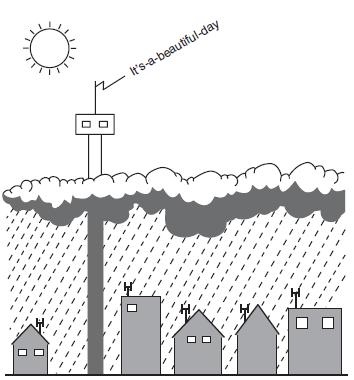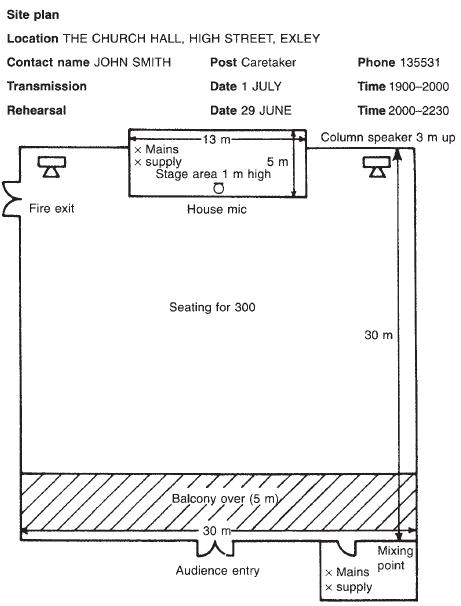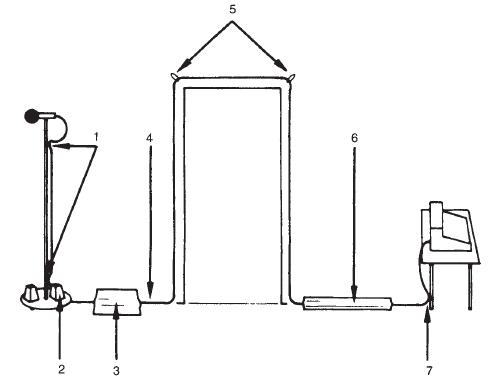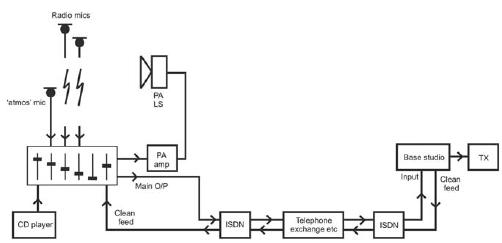16
Outside broadcasts (remotes)
As has been noted elsewhere, there is a tendency for broadcasters to shut themselves away in studios being enormously busy making programmes which do not originate from a direct contact with the audience. The outside broadcast, or ‘remote’, represents more than a desire to include in the schedule coverage of outside events in which there is public interest. It is a positive duty for the broadcasters to escape from the confines of their buildings into the world that is both the source and the target for all their enterprise. The concert, church service, exhibition, civic ceremony, sporting event, public meeting, conference or demonstration, these demand the broadcaster's attention. But it is not only good for radio to reflect what is going on, it is necessary for the station's credibility to be involved in such things. Radio must not only go to where people are, it must come from the interests and activities of many people. If its sources are too few, it is in danger of appearing detached, sectional, elitist or out of touch. Thus, the OB is essential to broadcasting's health.
Figure 16.1 The radio station must involve itself in its own community, otherwise it will appear irrelevant and out of touch
Planning
The producer in charge, together with the appropriate engineering staff, must first decide how much coverage is required of a specific event. The programme requirement must be established and the technical means of achieving it costed. Is it to be ‘live’ or recorded on-site? What duration is expected? Once there is a definite plan, the resources can be allocated – people, facilities, money and time.
It is also at this first stage that discussions must take place with the event organizer to establish the right to broadcast. It may be necessary to negotiate any fees payable, or conditions or limitations which the promoter or sponsor may wish to impose.
Visiting the site
A reconnaissance is essential, but it may take considerable imagination to anticipate what the actual conditions will be like ‘on the day’. There are a number of questions which must be answered:
1 Where and of what type are the mains electricity supply points? Is the supply correctly earthed? Do I need my own battery or power generator?
2 Where is the best vantage point to see the most action? Will there have to be more than one?
3 Will the sound mixing be done in a building or in a radio OB vehicle outside?
4 What on-site communications are required, e.g. reverse talkback needing headsets?
5 How many microphones and what type will be needed?
6 If radio mics, is anyone else using the same or adjacent frequencies?
7 How long are the cable runs?
8 Will a public address system be in use? If so, where are the speakers?
9 What else will be present on the day? For example, flags which obscure the view, vehicles or generators which might cause electrical interference, background music, other broadcasters.
10 What are the potential hazards and safety requirements?
Figure 16.2 A sketch plan drawn up during the site visit is an invaluable aid to further planning
Communications to base
If the programme is ‘live’, how is the signal to be sent to the controlling studio? What radio links are required? Is the site within available radio car range? Are ISDN land lines available? They may be expensive but will additional programme or control circuits need to be ordered from the Telecommunications Department? If so, will the quality be good enough for music – or will the programme circuit have to be ‘equalized’? These questions need to be discussed at an early stage, for, amongst other things, the answers will have a direct bearing on the cost of the programme.
Sooner or later an OB will be required from a hall or from the middle of a field, where no lines exist. Such conditions are best realized well in advance so that either a satellite or radio link can be obtained or the telephone authority asked to make the appropriate connections, and if necessary build a suitable route. A decision has to be made as to whether only a one-way programme circuit is required – the broadcaster at the site must then be able to obtain the cue to go ahead by listening off-air – or whether a second two-way telephone or control line is also needed. This additional facility is obviously preferred and perhaps a mobile phone will suffice. Certainly, for an OB of any length or where a number of broadcasts are made from the same site, an ordinary communications link becomes essential. The same applies if radio links are used – is there to be a bidirectional control channel in addition to the programme circuit from OB to base? The specialist producer will certainly know about the mobile phone and ISDN options (described earlier on pp. 75–77). If all else fails, however, it is a wise precaution to know the whereabouts of the nearest accessible telephone, whether it is in a private house or office, or a public call box. Many a programme has been saved by having the right coins available!
People
By this stage it should be clear as to how many people will be involved at the OB site. Anything more than a simple radio car or mobile phone job may require a number of skills – producer, engineer, floor manager, commentator, technical operator, secretary, driver, caterer, etc. A large event with the public present, such as an exhibition, may require the services of security staff or a publicity specialist. The list grows with the complexity of the programme, as does the cost.
The exact number of people is an important piece of anticipation – getting it right depends on being able to visualize whether, for example, there is a scriptwriting and typing requirement on-site. It will also depend on whether the working day is to be so long as to warrant the employment of duplicate staff working in shifts.
Hazard assessment
Away from the familiarity of the home studio, OBs are full of uncertainties. During the reconnaissance visit there must be a careful assessment of the potential hazards, and for the safety of staff, performers and members of the public, plans made to minimize them. This applies not only to the broadcast, but also to the rigging and derigging before and afterwards.
What measures are needed for crowd control – especially children? Are there any dangers from water, fire, heights, vehicles, traffic, animals, aircraft, etc.? Are hard hats, fluorescent jackets or any protective clothing needed? What contingency plans exist for dealing with an emergency? Should the police or other authorities be informed? No activity of this nature is entirely without risk, but responsible steps must be taken to anticipate and avoid possible accidents. See the model Hazard Assessment Form on the CD, Ch 16-1.
Equipment
This is best organized on a category basis by the individuals most closely involved:
1 Engineering – microphones including radio mics, cables, leads and connectors, audio mixers, computer kit and software, TV video link, cassette or DVD/CD decks, recorders, amplifiers, loudspeakers, headphones, blank DVD/CDs for recording, editing materials, digital Fx unit, radio, spare batteries, power cables and distribution boards, isolating transformers, circuit breakers, spare fuses, heavy-duty sticky tape, tool kit, fire extinguisher.
2 Programme – CDs, minidiscs, scripts, stopwatches.
3 Administrative – tables, chairs, paper, laptop or notebook, printer and ink cartridges, sticky labels, pens and pencils, marker pens, torches, clipboards, money, string, publicity and sign-writing materials, sticky tape, badges, mobile phone.
4 Personal – food and drink, special clothing, first aid kit, sleeping bags, umbrellas, etc.
5 Transport – vehicles, fuel can, maps, mallet, posts, rope, shovel.
There are always things that get forgotten, but if they are really important, this only happens once.
Safety
In a situation where crowds of people are present and their attention is inevitably drawn to the spectacle they have come to see, broadcasters have a special responsibility to ensure that their own operation does not present any hazards. They are of course affected by, and must observe, any by-laws or other regulations that apply to the OB site. Equipment must not obstruct gangways or obscure fire exit notices, or the fire equipment itself. Everyone working on the site should have a fire drill briefing and know the location of the Fire Assembly Point.
Cables across pavements or passageways must either be covered by a ramp or should be lifted clear of any possibility of causing an obstruction.
Microphones suspended over an audience must be securely fixed, not just with sticky tape which can become loosened with a temperature change, but secured in such a way as to prevent any possibility of their being untied by inquisitive or malicious fingers. Safety chains should doubly secure any equipment rigged overhead.
Figure 16.3 Microphones and cables must be safely rigged. 1. Cable taped to mic stand. 2. Stand weighted. 3. Mat covers cable at walkway. 4. Cable laid without loops or knots. 5. Cable slung over doorways. 6. Cable taped to floor. 7. Cable made fast at mixer end
Members of the public are generally curious of the broadcasting operation and all equipment must be completely stable – for instance, microphone stands or loudspeakers should not be able to fall over. Nor, of course, must straying hands be able to touch mains electricity connections. Some fencing off may be necessary.
This will almost certainly be the case where a ground-level public address system is in use. For a DJ show where the broadcaster is providing an on-site loudspeaker output, the sound intensity close to the speakers is often sufficient to cause temporary, and in some cases permanent, damage to ears. To prevent this, some form of barrier three metres or so from the speaker is generally needed. A better alternative is to raise the speakers, fixing them securely well above head height.
Accommodation
In further discussion with the event organizer there has to be agreement on the exact location of the broadcasting personnel and equipment. There may be special regulations governing car parking or access to the site, in which case the appropriate passes and security badges need to be obtained.
In order to rig equipment it will be necessary to gain access well before the event – are any keys required? Who will be there – and what security exists to safeguard equipment once it is rigged? At this stage the producer must also be clear as to the whereabouts of lavatories, fire exits, catering facilities, lifts and any special features of the site, e.g. steps, small doorways, awkward passages, non-opening windows or unusual acoustics.
The audio mixer frequently remains outside in the OB vehicle or is in a room from which the action cannot be seen. Under these conditions it is extremely useful to have a TV camera feeding a monitor close to the mixing desk so that the event can be followed – and anticipated – by the producer and engineer. The security and siting of the camera should be agreed with the event organizer in advance.
Programme research
Further discussion with the event organizer will establish the detailed timetable and list of participants. With an open-air event such as a parade or sports meeting, it is important to discover any alternative arrangements in case of rain. As much information as possible about who is taking part, the history of the event, how many people have attended on previous occasions, and so on, is useful preparatory material for the broadcast itself. Additional research using libraries, press cuttings, the Internet, etc. may be necessary at this stage for the commentators (see Chapter 17).
The producer is then in a position to draw up a running order and to tell everyone his or her precise role, both on and off the air. The running order should give as much relevant information as possible, including who is doing what, when, together with details of cues and timings, where these are known.
Figure 16.4 A live OB working with the base studio. Covering musicians and an audience, providing PA and playing in CDs, the OB provides programme via an ISDN line to the base studio for transmission. The base studio provides a clean feed back to the OB consisting only of material originating at base
Liaison with the base studio
Particularly in the case of a ‘live’ OB, staff at the base studio need to be kept informed of what is planned and what alternatives exist. They should have copies of the running order and be involved in a discussion of any special fill-up material or other instructions in case of a technical failure. Arrangements should be made for a ‘live’ OB to be recorded at the base studio so that a possible feature can be made for a highlight or follow-up programme.
Publicity
The producer should ensure that everything has been done to secure the appropriate advance publicity. This may be in the form of programme billing, printed posters, a press release, or simply on-air trails and announcements. It is a matter of common experience that broadcasters go to immense pains to cover an important public event, but overlook the necessity of telling people about it in advance. It is true that some promoters claim that broadcast coverage keeps people away from attending the event itself but, on the other hand, it is frequently the case that advance publicity will stimulate public interest and swell the crowds, many of whom will then follow the action via radio.
Conflicts of approach
Engineers are essential to the broadcasting process and programme people ought to know that they wouldn't get far without them – especially at an outside broadcast. While producers might well be criticized for taking too little interest in technical matters, it also has to be said that some engineers have a tendency to over-complicate things. They can use far too many mics or have an undue liking for technical gimmicks, and they do not always explain to the producer, as fully as they might, the problems and possibilities of the situation. Furthermore, the mixing desk is often operated by a technician or specialist OB engineer and so the final mix – the programme sound – is not under the producer's direct control. So while an engineer at an OB may be aiming at studio speech quality and acoustically perfect sound, the producer may want much more the event – a sense of the occasion. Because of such differences of approach, it is not surprising that arguments arise between producers and engineers. The problem is generally compounded by the stressful pressure of time.
A common difficulty with the broadcasting of live events involving music is the frequent lack of any proper rehearsal. It is often not possible to listen to the mix, discuss it, make adjustments and do it again. It is therefore essential that the producer discusses his or her objectives with the balance engineer well in advance and maintains close contact to resolve problems as they arise. Confronted by an engineer of many years’ experience, the young producer is likely to feel daunted by the older person and unable to question anything said or done. By all means use that experience, depend on that competence and learn from it – but also develop the personal skills to challenge precedent and make changes if you feel it right. After all, in most broadcasting organizations it is the producer who is in charge – and responsible for the end result.
Tidiness
The broadcaster is working in a public place and, both in terms of appearance and general behaviour, will contribute to the station's image. This is recognized by the more senior staff but may not always be appreciated by freelance contributors. A small but important aspect of public relations is the matter of leaving the OB site in a sensibly tidy state. It is clearly undesirable to leave any equipment behind, but this should also apply to the accumulated rubbish of a working visit – scripts, notes, food tins, plastic bags, empty boxes, etc. To be practical, a good OB site will be required again and it is not in the broadcaster's interests to be remembered for the wrong reasons.
Gratuities
It is common sense to recognize that the broadcaster's presence at an OB site is likely to cause extra effort for those who normally work there. It will not be necessary to consider this point in every case, and it may even be felt that where there is some special distinction attached to broadcasting it is possible to live off that good name. This temptation should be resisted, for every time that status is used in this way, it is likely to be diminished. A facility fee should be paid where local assistance is provided beyond the normal level, and to any outsiders who supplied some special service – for example, the use of a telephone, electricity or water, or the parking of vehicles. The amounts should obviously be related to the service provided – too much and one is open to a charge of profligate wastage, too little and one does more harm than good. It may, on the other hand, be sufficient to send a letter of thanks. These are the niceties of a well judged operation.




